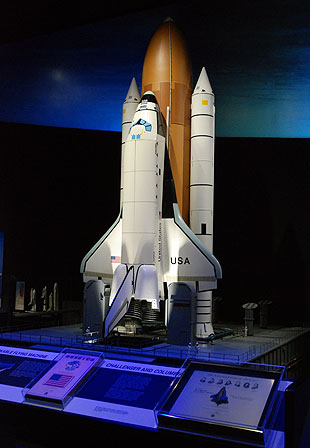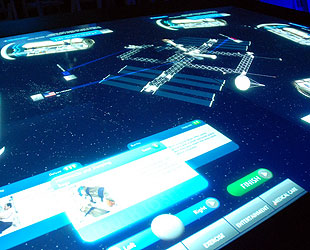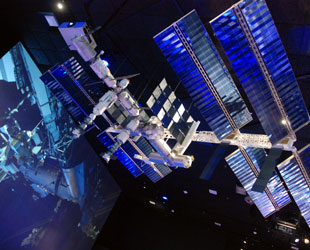November 19, 2009 — The camera that captured many of the Hubble Space Telescope's most famous images and the "contact lenses" that focused the observatory's flawed mirror debuted Wednesday at the Smithsonian's National Air and Space Museum in Washington, DC along with the first phase of a new interactive gallery devoted to humans living and working in space.
"Moving Beyond Earth", which replaces the prior Rocketry and Space Flight gallery that originally opened just before the start of the space shuttle era in 1979, seeks to tell the story of the U.S. Space Transportation System (STS) and the accompanying efforts to build a space station with an approach mimicking NASA's own history.
"The gallery is in its first stage," explained curator Valerie Neal. "What you see here today is essentially a footprint for what will be a fully built-out gallery in the next two years. We are approaching this incrementally, just as NASA approached the International Space Station. We are not doing it all at once, we're phasing it in, element by element."

The 12-foot tall, 1/24 scale space shuttle model. (collectSPACE) |
Currently on display are mostly space shuttle artifacts and displays that were previously exhibited in other galleries, accompanied by state-of-the-art touch-screen and button-enabled interactives designed to engage a new generation of visitors.
"We were very sparse on artifacts," shared Neal during a press preview. "The artifacts for the space shuttle era were all in use. NASA has been reusing and recycling and holding close everything needed. Thus artifacts are now just about to begin to be released. The ability for us to display the Hubble artifacts is a signal of that availability."
Space artifacts as space holders
The artifacts on display reflect the exhibition's three main themes: Moving into Space, Living and Working in Space and Envisioning our Future in Space.
"Moving Into Space is where we deal with the challenges and choices involved in the quest to establish routine and reliable, economical and safe transportation into space," Neal described. "The signature artifact being of course the space shuttle, represented by a large model."
The 12-foot 1/24 scale shuttle model was moved from the neighboring Space Race gallery, where it stood next to the full-size engineering model of the Hubble Telescope. Its replacement is the 619 pound, 3 foot by 7 foot Wide-Field Planetary Camera 2 (WFPC2), which itself was replaced aboard the Hubble after 16 years of capturing many, if not most of the observatory's most famous images.

Wide-Field Planetary Camera 2 (WFPC2) on display under a full scale model of the Hubble Space Telescope. (collectSPACE) |
"The next section deals with Living and Working in Space and the challenges of making a home in space, where microgravity gives us both an opportunity, particularly an opportunity for doing scientific research, but it is also a hazard," continued Neal.
"One significant portion of that part of the exhibition is extravehicular activity for spaceflight. The spacewalks on the servicing missions to the Hubble Space Telescope were quiessential spacewalks; they tasked humans to the utmost to do highly precise work in space under pretty grueling circumstances."
"We will be highlighting the Hubble servicing missions in the fully [decked] out gallery but COSTAR and also the Power Control Unit trainer in the corner here hold the footprint for that section, as does the International Space Station model above," said Neal, referencing the Hubble's Corrective Optics Space Telescope Axial Replacement on display alongside a mockup of the observatory's electrical nerve center that was used to train astronauts.
The Hubble instruments will be on display through mid-December. They then will travel to southern California to go on temporary exhibit at several venues. In March 2010, the instruments will return to the Air and Space Museum, where they will take up permanent residency.
Moving further around the room, visitors find the Russian Sokol pressure suit worn by space tourist Dennis Tito and a model of NASA's proposed Ares launch vehicle.
"Our third section, Envisioning our Future in Space, will be looking at the questions, challenges and choices ahead for planning a human future in space," said Neal. "What is the mix between commercial spaceflight and government sponsored spaceflight? What is the mix between human and robotic presences? What is the mix between science and just basic travel and exploration? All of that is yet to come."
Much of the room's contents are yet to come, too, but the gallery in its present phase is not empty.
Walking through the gallery, visitors find themselves "in orbit" by an expansive rotating view of the Earth that drifts over one gallery wall, while a fly-around tour of the space station fills another.

Flat table touch-screen display of Design It! challenges visitors to build a space station. (collectSPACE) |
"Also holding the footprints for the first stage are a series of interactives that are loaded with content that is keyed to the artifacts and the exhibition," Neal described.
Among the computer-powered challenges are: Spaceflight Academy, a multi-player trivia game; Be A Flight Director, where users make decisions based on a real shuttle flight; Design It!, using a flat table touch-screen to build a space station; and Space For You?, identifying potential careers in space based on a user's profile.
Continuing the story
"[These have been] called artifacts, which is kind of an odd term; these are instruments that I trained for years to work with and to take out and to bring back, so to me they are very much alive, not artifacts," stated astronaut John Grunsfeld, whose five flights onboard the shuttle included three visits to the Hubble Space Telescope.
Grunsfeld, who was on hand at the museum for the debut of the gallery and the Hubble instruments-turned-artifacts, drew parallels between the exhibit and the missions it was designed to represent.
"The wonderful thing about the Hubble Space Telescope and also this gallery, which is different from many parts of the National Air and Space Museum, is that the Hubble story is still continuing, even though we have some items back," he explained.

A model of the space station is suspended before a projection wall providing a tour of the outpost. (collectSPACE) |
"It is also the story of the International Space Station. We have a crew on Atlantis now, six crew members went up on Monday, and there are six crew members onboard [the station], so that is an active story, so keep in mind when you look at the graphics [in the gallery] that there are people living and working in space, 365/24/7. So this gallery will also be part of that living story."
"As we push out of low Earth orbit, hopefully we will go and do some incredible things that will be both exciting and innovative, those will too, be part of this gallery and maybe some of the kids who come in and work with the Spaceflight Academy and pretend to be flight directors will be part of that story."
"So I am looking forward to the future exhibits here," said Grunsfeld.
Click here for more photos from "Moving Beyond Earth."
